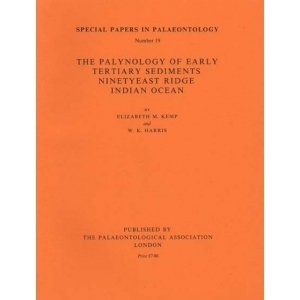
Specials Papers in Paleontology: 19
<br />1977
<br />
<br />The palynology of Early Tertiary sediments, Ninety-East Ridge, Indian Ocean.
<br />E M Kemp and W K Harris
<br />
<br />74 pp., 8 pls.
<br />
<br />ABSTRACT. Assemblages of spores and pollen are recorded from volcanogenic sediments immediately above oceanic basement at drill sites on the Ninetyeast Ridge, Indian Ocean, and are believed to reflect the vegetation of islands which were emergent along the ridge crest in the Palaeogene. At Site 214, the assemblages were recovered from sediments interpreted, on foraminiferal, coccolith, and palynological evidence, as being of mid Palaeocene age. At Site 254, age estimates are ambiguous, but the palyniferous unit is overlain by units dated as middle to late Oligocene on foraminiferal evidence, and seems likely to be Oligocene itself. A total of seventy-one form-species has been identified from the sites. Fourteen of these are instituted as new species, and include Arecipi/es insularis Harris, Cicatricosisporites teniatus Harris, Appendicisporiles crassicarina/us Harris, Echiperiporiles ro/undus Kemp, Myr/aceidi/es oceanicus Kemp, Nyssapolleni/es deminu/us Harris, Punc/a/ospori/es varigranula/us Kemp, Rhoipiles grandis Kemp, R. isore/icula/us Kemp, R. microluminus Kemp, Sparganiaceaepolleni/es irregularis Kemp, Stoverisporites verrucolabrus Kemp, Simpsonipollis mulleri Kemp, and Tricolpi/es discus Harris.
<br />Assemblages from both sites have much in common with Early Tertiary microfloras from Australia and New Zealand; of the total number ofform-species, forty-two have been previously described from Australia, seventeen from New Zealand. Families occurring in the island floras which have a general southern distribution include Myrtaceae, Proteaceae, Restionaceae, Gunneraceae, Chloranthaceae, Araucariaceae, and Podocarpaceae. Although reconstructions of the Indian Ocean suggest that the island sites were closer to southern land masses than they are now, it seems that they were truly oceanic in position, and it is argued that establishment of the floras must have occurred through long-distance dispersal mechanisms.